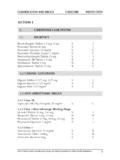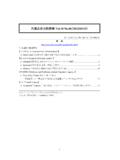Transcription of NEW ZEALAND DATA SHEET - Medsafe
1 Version:pfdneura11217 Supersedes: pfdneura10617 Page 1 of 22 NEW ZEALAND data SHEET1. PRODUCT NAMENEURONTIN 100 mg , 300mg and 400mg capsulesNEURONTIN 600 mg and 800mg film coated tablets2. QUALITATIVE AND QUANTITATIVE COMPOSITIONEach 100mg capsule contains 100 mg of 300mg capsule contains 300 mg of 400mg capsule contains 400 mg of 600mg tablet contains 600 mg of 800mg tablet contains 800 mg of with known effect:Each 100mg capsule contains 13mg lactose (as monohydrate).Each 300mg capsule contains 41mg lactose (as monohydrate).Each 400mg capsule contains 54mg lactose (as monohydrate).For the full list of excipients, see section PHARMACEUTICAL FORM 100 mg capsules: Size C capsules with white opaquebody and cap, blue imprint Neurontin 100 and PD . 300 mg capsules: Size B capsules with yellow opaque body and cap, grey imprint Neurontin 300 and PD .400 mg capsules : Size A capsules with orange opaque body and cap, grey imprint Neurontin 400 and PD .600 mg tablets: White, elliptical film-coated tablets with bisecting score on both sides and debossed with NT and 16 on one mg tablets: White, elliptical film-coated tablets with bisecting score on both sides and debossed with NT and 26 on one :pfdneura11217 Supersedes: pfdneura10617 Page 2 of 224.
2 CLINICAL Therapeutic indicationsNEURONTIN is indicated for the treatment of partial seizures with or without secondarily generalised tonic-clonic seizures, in adults and children age 3 years and above who have not achieved adequate control with standard anti-epileptic drugs (see section ).NEURONTIN is indicated for the treatment of neuropathic pain (see section ). Doseand method of administrationEpilepsyAdults and Children Older than 12 Years of AgeInitiation of treatment should be as add-on therapy. Gabapentin can be given orally with or without controlled clinical trials, the effective dose range was 900 mg/day to 1800 mg/day given in divided doses (three times a day).Therapy may be initiated by administering 300 mg of gabapentin three times a day on Day1 or by titrating the dose as described to an effective dose can take place rapidly, over a few days, by giving 300 mg NEURONTIN on Day1, 300 mg NEURONTIN twice a day on Day2, and 300 mg NEURONTIN three times a day on Day 3.
3 Titration may be preferable for patients with renal impairment, patients with encephalopathy, patients on more than 2 other antiepileptic medications and patients with multiple other medical minimise potential side effects, especially somnolence, dizziness, fatigue and ataxia, the first dose on Day1 may be administered at bedtime. If necessary, the dose may be increased using 300 mg or 400 mg capsules or 800 mg tablets three times a day up to 2400 mg/day. Dosages up to 2400 mg/day have been well tolerated in long-term open-label clinical studies. The maximum time between doses in the three times a day schedule should not exceed 12 hours to prevent breakthrough Aged 3to 12 Years of AgeThe effective dose of NEURONTIN is 25 mg/kg/day to 35 mg/kg/day given in divided doses (3 times a day) as described in Table 1. Initial titration to an effective dose can take place over 3 days by giving 10 mg/kg/day on Day 1, 20 mg/kg/day on Day 2, and 30 mg/kg/day on Day 3. Thereafter, the dose can be increased in three equally divided doses up to a maximum dose of 35mg/kg/day.
4 Dosages up to 40mg/kg/day to 50 mg/kg/day have been well tolerated in a long-term clinical study. Doses of 60 mg/kg/day have also been administered to a small number of 1: Dosage of Gabapentin in Paediatric Patients Age 3-12 YearsWeight Range(kg)Daily Dose(mg/day)Version:pfdneura11217 Supersedes: pfdneura10617 Page 3 of 2217 2560026 -3690037 -50120051 -721800 Unlike other agents in this class, it is not necessary to monitor gabapentin plasma concentrations to optimise NEURONTIN therapy. Further, NEURONTIN may be used in combination with other antiepileptic drugs without concern for alteration of the plasma concentrations of gabapentin or serum concentrations of other antiepileptic drugs. If NEURONTIN is discontinued and/or an alternate anticonvulsant medication is added to the therapy, this should be done gradually over a minimum of PainAdults Older than 18 Years of AgeThe starting dose is 900mg/day given in three equally divided doses, and titrated if necessary, based on response, up to a maximum dose of 3600 Adjustment in Impaired Renal Function in Patients With Neuropathic Pain Or EpilepsyDose adjustment is recommended in patients with compromised renal function as described in Table 2 and/or in those undergoing 2: Dosage of gabapentin in adults based on renal functionCreatinine Clearance (mL/min)Total Daily Dosea(mg/day) 80900-360050-79600-180030-49300-90015-29 150b-600<15150b-300aTotal daily dose should be administered as a divided three time a day regimen.
5 Doses used to treat patients with normal renal function (creatinine clearance 80 mL/min) range from 900 mg/day to 3600 mg/day. Reduced dosages are for patients with renal impairment (creatinine clearance 79 mL/min).b To be administered as 300mg every other Adjustment in Patients Undergoing HaemodialysisFor patients undergoing haemodialysis who have never received gabapentin, a loading dose of 300 mg to 400mg is recommended, and then 200mg to 300mg of gabapentin following each 4 hours of ContraindicationsNEURONTIN is contraindicated in patients who have demonstrated hypersensitivity to gabapentin or the inactive ingredients in the capsules and :pfdneura11217 Supersedes: pfdneura10617 Page 4 of Special warnings and precautions for useGeneralAlthough there is no evidence of rebound seizures with gabapentin, abrupt withdrawal of anticonvulsants in epileptic patients may precipitate status epilepticus. When in the judgement of the clinician there is a need for dose reduction, discontinuation, or substitution of alternative anticonvulsant medication, this should be done gradually over a minimum of one is generally not considered effective in the treatment of absence seizures and may exacerbate these seizures in some patients.
6 Consequently, NEURONTIN should be used with caution in patients who have mixed seizure disorders that include absence treatment has been associated with dizziness and somnolence, which could increase the occurrence of accidental injury (fall). There have also been post-marketing reports of confusion, loss of consciousness and mental impairment. Therefore, patients should be advised to exercise caution until they are familiar with the potential effects of the DepressionGabapentin has been associated with central nervous system (CNS) depression including sedation, somnolence, loss of consciousness as well as serious cases of respiratory depression. This may occur without concomitant opioid use. Patients with compromised respiratory function, respiratory or neurological disease, renal impairment and the elderly are at higher risk of experiencing these severe adverse effects. Concomitant use of CNS depressants with gabapentin increases the risk of respiratory who require concomitant treatment with opioids may experience increases in gabapentin concentrations.
7 Patients should be carefully observed for signs of central nervous system (CNS) depression, such as somnolence, sedation and respiratory depression and the dose of NEURONTIN or opioid should be reduced appropriately (see section ).Suicidal Behaviour and IdeationAntiepileptic drugs (AED), including gabapentin, increase the risk of suicidal thoughts or behaviour in patients taking these drugs for any indication. Patients treated with any AED for any indication should be monitored for the emergence or worsening of depression, suicidal thoughts or behaviour, and/or any unusual changes in mood or analyses of 199 placebo-controlled clinical trials (mono- and adjunctive therapy) of 11 different AEDs showed that patients randomised to one of the AEDs had approximately twice the risk (adjusted Relative Risk , 95% , ) of suicidal thinking or behaviour compared to patients randomised to placebo. In these trials, which had a median treatment duration of 12 weeks, the estimated incidence rate of suicidal behaviour or ideation among 27,863 AED-treated patients was , compared to among 16,029 placebo-treated patients, representing an increase of approximately one case of suicidal thinking or behaviour for every 530 patients treated.
8 There were four suicides in drug-treated patients in the trials and none in placebo-treated patients, but the number is too small to allow any conclusion about drug effect on increased risk of suicidal thoughts or behaviour with AEDs was observed as early as one week after starting drug treatment with AEDs and persisted for the duration of treatment Version:pfdneura11217 Supersedes: pfdneura10617 Page 5 of 22assessed. Because most trials included in the analysis did not extend beyond 24 weeks, the risk of suicidal thoughts or behaviour beyond 24 weeks could not be risk of suicidal thoughts or behaviour was generally consistent among drugs in the data analysed. The finding of increased risk with AEDs of varying mechanisms of action and across a range of indications suggests that the risk applies to all AEDs used for any indication. The risk did not vary substantially by age (5-100 years) in the clinical trials analysed. Table 3 shows absolute and relative risk by indication for all evaluated 3: Risk by Indication for Antiepileptic Drugs in the Pooled AnalysisIndicationPlacebo Patients with Events Per 1000 PatientsDrug Patients with Events Per 1000 PatientsRelative Risk: Incidenceof Events in Drug Patients/Incidence in Placebo PatientsRisk Difference: Additional Drug Patients with Events Per 1000 relative risk for suicidal thoughts or behaviour was higher in clinical trials for epilepsy than in clinical trials for psychiatric or other conditions, but the absolute risk differences were similar for the epilepsy and psychiatric considering prescribing gabapentin or any other AED must balance this risk with the risk of untreated illness.
9 Epilepsy and many other illnesses for which AEDs are prescribed are themselves associated with morbidity and mortality and an increased risk of suicidal thoughts and behaviour. Should suicidal thoughts and behaviour emerge during treatment, the prescriber needs to consider whether the emergence of these symptoms in any given patient may be related to the illness being , their caregivers, and families should be informed that AEDs increase the risk of suicidal thoughts and behaviour and should be advised of the need to be alert for the emergence or worsening of the signs and symptoms of depression, any unusual changes in mood or behaviour, or the emergence of suicidal thoughts, behaviour, or thoughts about self-harm. Behaviours of concern should be reported immediately to the treating Rash with Eosinophilia and Systemic SymptomsSevere, life-threatening, systemic hypersensitivity reactions such as drug rash with eosinophilia and systemic symptoms (DRESS) have been reported in patients taking antiepileptic drugs including is important to note that early manifestations of hypersensitivity, such as fever or lymphadenopathy, may be present even though rash is not evident.
10 If such signs or symptoms are present, the patient should be evaluated immediately. NEURONTIN should be discontinued if an alternative aetiology for the signs or symptoms cannot be :pfdneura11217 Supersedes: pfdneura10617 Page 6 of 22 AnaphylaxisNEURONTIN can cause anaphylaxis. Signs and symptoms in reported cases have included difficulty breathing, swelling of the lips, throat, and tongue, and hypotension requiring emergency treatment. Patients should be instructed to discontinue NEURONTIN and seek immediate medical care should they experience signs or symptoms of and DependencePost-marketing cases of abuse and dependence have been reported with with other CNS drugs, patients should be carefully evaluated for a history of drug abuse and observed for possible signs of gabapentin on Laboratory TestsFalse positive readings were reported with the Ames N-Multistix SG dipstick test when gabapentin was added to other anticonvulsant drugs. To determine urinary protein, the more specific sulfosalicylic acid precipitation procedure is for PatientsTo assure safe and effective use of NEURONTIN, the following information and instructions should be given to patients:1.











